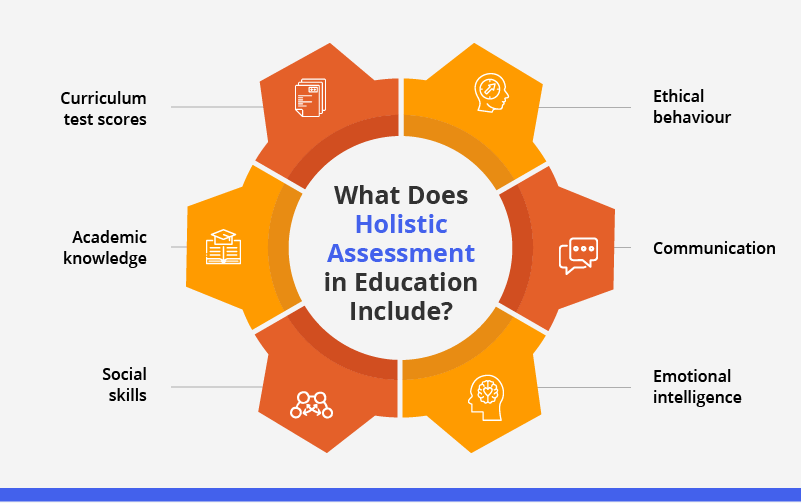Holistic Assessment in Schools – All You Need to Know About

Since the adoption of NEP 2020, the focus of the Indian education system has been moving away from rote learning to comprehensive development for better learning outcomes. Recently, there has been an emphasis on transforming the assessment systems by adopting a more practical and holistic approach.
What is Holistic Assessment?
Holistic assessment involves collecting and using information from multiple resources to guide and support learning. Instead of focusing on just numbers, holistic assessment approaches evaluation with a focus on quality and balance.
For example, in healthcare, a comprehensive checkup before the beginning of a treatment can give you a complete health status and determine the goals of the treatment. At the end of the treatment, another comprehensive checkup can show the holistic results of the treatment.
What is Holistic Assessment in Education?

In education, holistic assessment is founded on the belief that schooling goes beyond curriculum and academic knowledge. It uses a comprehensive approach to address a student’s social, ethical, and intellectual needs through an integrated learning experience.
An essential aspect of modern education and holistic assessment is ensuring students contemplate their actions’ results. At the end of the learning experience, learners should appreciate their decisions’ global and local impact.
Bottom line, holistic assessments typically measure a student’s progress over time and identify the areas where students need additional support. This method, simply put, is a way of figuring out the strengths and weaknesses of a student based on several performance metrics and not just their marks or grades. When executed well, it helps teachers and educators draw a path or a strategy map, so to speak, for each student.
Benefits of Holistic Assessment
Holistic assessment has many benefits for all education systems. But it works exceptionally well for K-12 students – because this approach involves developing a comprehensive understanding of a learner’s journey over many years. The main benefit is that it enables educators to understand learners’ needs and empower them with personalised learning like never before.
Benefits of Holistic Assessment for Teachers & Educators
- Expands the Possibilities of New Learning Outcomes: With the new holistic assessment approach, teachers don’t need to limit learning to traditional subjects. As holistic assessment is not confined to tests and scores, it is now possible for teachers to include life skills and new learning experiences in their courses. By diversifying the potential learning outcomes, holistic assessment helps students better prepare for life in the fast-paced world.
- Better Insight into Individual Strengths & Weaknesses: Traditional assessments emphasise less on the unique strengths of a learner and more on numeric measures of their memory power. Holistic assessment in education enables teachers to understand each learner’s strengths, weaknesses, and motivations, leading to more effective teaching strategies.
- Enhanced Curriculum Mapping: Curriculum mapping is critical for personalised instruction. A holistic assessment helps teachers map the curriculum to match the learner’s needs and pace. An aligned curriculum is essential for a comprehensive and relevant learning experience.
- Trainer-Learner Relationship: Holistic assessment improves the educator’s understanding of each student. When trainers understand every student’s inherent talent, challenges, and needs – it leads to stronger bonds among teachers and students. A better understanding can help foster empathy and reduce bias to create a more conducive learning environment.
- Consistent Feedback: The learners receive regular feedback that is constructive and consistent to help them grow. Holistic assessments help learners develop their knowledge and skills with developmental feedback that they can use to improve as learners for life.
- Personalised Instruction & Support: Holistic assessments complement personalised instruction and support methodologies to enhance student learning. Educators can use the insights from holistic assessments to understand their learners’ needs to adapt their pedagogy and offer individualised feedback accordingly.
- Professional Development: Adopting holistic assessments and personalised instruction encourages teachers to continuously work on their pedagogy, assessments, and student interactions. It also motivates educators to stay current with the latest education trends and participate in professional development.
- Job Satisfaction: Teachers and educators feel rewarded when their learners progress and achieve their learning goals. Holistic assessments ensure that an educator’s efforts don’t just help students gain knowledge but develop as well-rounded individuals. An individualised pedagogy and holistic assessment systems can help teachers feel more satisfied and accomplish such goals.
- Opportunities to Collaborate: Holistic assessment offers teachers and educators numerous opportunities to collaborate with fellow educators, parents, and others to create a comprehensive learning experience. Collaboration in teaching can lead to more opportunities for sharing learning experiences and finding opportunities for professional growth.
- Inclusivity in Education: Holistic assessment allows educational institutions to include students from all backgrounds, learning preferences, and intellectual groups. It will enable teachers to offer special students better support and learning guidance as they need. Thus, fostering inclusivity in education.
- Flexibility in Assessment: Teachers who use holistic assessment in teaching have the flexibility to experiment with different evaluation techniques, tools, and strategies to ensure the all-round development of their students. The Assessment Centre by Extramarks allows teachers to use other forms of assessment before deciding the one that best fits their course and learner needs.
Benefits of Holistic Assessment for Students
- Helps Develop a Comprehensive Understanding & Skill Base: Students who study in institutions with holistic assessments develop valuable skills that can be used for better learning in multiple areas of study. They also attain a deeper understanding of the subject matter when they are assessed in various facets of learning.
- Problem Solving & Critical Thinking: By eliminating rote memorisation from education, learners can develop their critical thinking and problem-solving abilities. Holistic assessment models push learners to analyse, evaluate and synthesise information in real-world challenges. It allows learners to apply their skills beyond academics to enable real-world readiness.
- Promotes Emotional and Social Development: Holistic assessment systems are designed to encourage students to pursue comprehensive growth. On the one hand, learners can use self-reflection to work on their emotional well-being, improve their interpersonal skills, and prepare for life’s challenges. On the other hand, self-awareness helps learners better understand their strengths and challenges.
- Significance of Self-Directed Learning & Individual Learning Styles: Holistic assessments enable students to choose their learning path and pace of learning. They can select their subjects of interest and pursue their passions within the education system. Besides, holistic assessments are adaptable to different learning styles and allow learners to showcase their knowledge in their own style.
- Boosts Self-Confidence: Evaluation based on scores and tests can hurt a learner’s self-esteem. Holistic assessment methods recognise growth beyond academic achievement and appreciate development in multiple facets of learning. It can help students improve their self-confidence.
- Equitable Learning: Holistic assessments promote an equitable and inclusive learning experience. It allows students from all backgrounds and learning preferences to get equal learning opportunities and high-quality learning experiences.
- Preparing for Real-Life Challenges A holistic assessment system complements the goal of education to impart practical skills to learners that prepare them for real-world challenges. By giving real-life scenarios it compels learners to apply their skills realistically.
- Focus on Growth: Holistic assessments shift the spotlight from marks to personal growth. From a young age, learners appreciate the value of knowledge and personal growth through education. Holistic assessments emphasise the importance of physical, emotional, social, and moral growth. It enables them to pursue continuous learning throughout their lives, constantly working on themselves to learn and improve.
- Exploring Own Creativity: Students get numerous opportunities to think creatively through diverse assessment methods, including projects, presentations, and assignments. Holistic assessments in education also help learners to stay curious and explore their subjects through in-depth research to express their knowledge creatively.
- Encourages Collaboration: Holistic assessments often include group projects and assignments. It allows students to work as a group, participate in peer reviews, and promote teamwork, communication, and collaborative problem-solving.
- Constructive Feedback: In holistic assessments, the emphasis is less on pointing out a student’s mistakes but rather on offering productive feedback that guides the learning towards improvement. Constructive feedback helps learners recognise their areas of improvement and enables them to overcome the challenges they had in the past and pursue overall development.
How to Implement Holistic Assessment in K-12 Education?
We just sae that implementing holistic assessment in teaching K-12 education has several advantages for teachers and students. However, adopting a brand-new method of evaluation is easier said than done. For many years, schools worldwide have been working to create well-developed assessment systems that make the entire education system efficient to accelerate learning, focusing on the identified learning gaps.
Here’s what all K-12 schools should do and include to adopt a holistic assessment method:
- Portfolio Assessment: Learners should be encouraged to compile all their work in an academic year. Documenting their projects, artwork, essays, assignments, and other evidence of learning shows a learner’s progress, achievements, and areas of growth.
- Observational Assessment: Teachers should observe their students during class, group work, and other interactions to gauge their social skills, ability to collaborate, quality of participation, and overall behaviour as a part of the assessment.
- Self & Peer Assessment: Objectively evaluating their work strengthens a learner’s self-awareness and critical thinking. Assessing the work done by their peers gives them a sense of responsibility. All these qualities are essential for overall personality development.
- Project-Based Assessment: Projects are a vital component of holistic assessments. They help students apply the knowledge and skills they have gained in a life-like scenario. Their performance in a project can help educators observe a learner’s problem-solving abilities, creativity, and practical application of knowledge.
- Presentations & Group Discussions: Presentations and discussions are excellent opportunities for learners to showcase their social skills, self-confidence, and collaboration ability. Educators should encourage debates and discussions to enable students to use their communication skills, articulate their thoughts in words, and demonstrate their understanding of the subject matter.
- Journals & Reflection Logs: Holistic assessments require learners to maintain daily journals and logs to help document their learning journey. These journals can be helpful for teachers to understand individual learning styles, experiences, difficulties, and areas of interest.
- Real-World Tasks: Including real-world tasks such as managing a community event, working on a budgeted project, or participating in social work helps assess students’ ability to apply their knowledge in practical situations.
- Hands-on Learning Experiences: No learning experience is complete without practically applying the knowledge gained. It can be done by asking learners to work together to organise a play, experimenting to prove the principles of science, or playing sports.
- Regular Feedback Sessions: Educators should organise regular feedback sessions to guide students on their learning path. Sharing their observations and discussing a student’s progress, strengths, and areas of improvement with students and parents can be instrumental in a student’s overall growth.
- Interdisciplinary Assessments: When conceptual knowledge is vital, students can integrate the principles of one subject with another to apply their knowledge to multidisciplinary projects. Use tasks that combine concepts of two or more subjects to create interdisciplinary assessments.
- Cultural & Social Context: Educators should consider students’ cultural, linguistic, and ethnic backgrounds when assessing their knowledge. It will help ensure inclusivity and equitable assessment.
- Digital and Tech-based Assessments: Schools and colleges understand the significance of technology skills for students today. In the real world, everyone needs to be adept at using digital technology in every field. Holistic assessments help educators assess digital literacy, technology skills, and online research abilities among learners.
- Collaborative Assessments: Collaborative assessments help educators observe students working in a group to analyse social skills, collaborative abilities, and participation in group tasks.
Extramarks Assessment Center
Extramarks Assessment Center offers customised solutions for automating assessment activities in an educational institution. Our state-of-the-art solutions leverage digital technology to revamp the assessment system of your school, thereby minimising the scope of error, expanding the repository of questions, and enabling instant evaluation.
Differences Between Traditional & Holistic Assessment
As it is apparent, there are several distinctions between traditional and holistic assessments. However, if you are an educator looking for more clarity on the differences between conventional and holistic assessment techniques. Here is a detailed look:
| Aspect | Traditional Assessment | Holistic Assessment |
| Focus | The focus is academic achievement and test scores. | The focus is a learner’s overall personal and educational development through an emphasis on emotional, social, and physical development. |
| Method | Tests are scored on predetermined benchmarks, and learners must depend on rote memorisation for good performance. | The holistic assessment method tests a learner’s knowledge through real-world problems and applying knowledge to solve them. |
| Feedback | The feedback is quantitative, typically comprising of scores or grades | The feedback is detailed and qualitative, covering growth areas, strengths, and scope for improvement. |
| Scope | The scope of traditional assessment is limited to specific skills, subject matter, or knowledge areas. | The broad scope comprises multiple facets of personality development for the learner |
| Flexibility | There is little flexibility as all learners must appear for the same test with set questions and answers. | Holistic assessment is adaptable and can be customised to suit a learner’s pace, learning style and needs. |
| Engagement | There needs to be more engagement in a traditional assessment. Learners receive information through lectures and books and must recall it during tests. | Active engagement: learners are encouraged to participate, reflect, and engage in learning. |
| Real World Relevance | Learners may need help to apply the knowledge gained to real-world situations. | All assignments and tasks mimic real-world challenges. It allows learners to apply their knowledge. |
| Cultural Consideration | It may not consider the learners’ cultural, linguistic, and individual backgrounds. | Inclusive method of assessment. It can be adapted to suit all students’ learning preferences and needs. |
| Duration | Traditional assessments are one-time events. They are usually held at the end of the term or twice a year. | Holistic assessment is continuous and offers periodic feedback to guide learners towards a more efficient learning trajectory. |
| Use of Technology | They have limited use of technology; sometimes, computer-based tests may be used instead of paper-based. | Extensive use of technology, digital tools and platforms are commonly used for a comprehensive assessment. |
The traditional evaluation methods are quickly losing relevance in holistic learning environments today. Learners should be free to progress as per their interests and talents instead of following a defined study pattern. When learning and development are holistic, the assessment system also needs to evolve and improve. The education and technology experts at Extramarks strive to empower schools with the best technological solutions that enable holistic development among learners.
Last Updated on November 11, 2024
Reviewed by

Priya Kapoor | AVP - Academics
Priya Kapoor is an accomplished education professional with over 18 years of experience across diverse fields, including eLearning, digital and print publishing, instructional design, and content strategy. As the AVP – Academics at Extramarks, she leads academic teams in creating tailored educational solutions, ensuring alignment with varied curricula across national and international platforms...read more.










